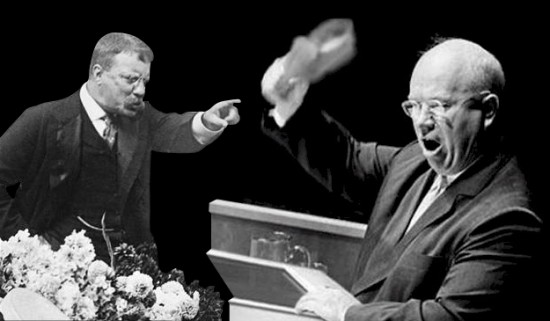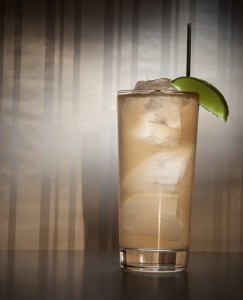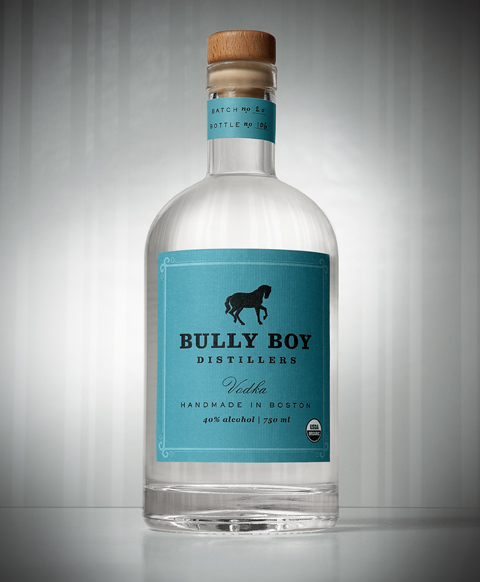Rule 37. Try one new drink each week.
The Rule 37 series of posts chronicle my attempts to accomplish this feat every week.
For the recipes of R37s past, click the Htf do I make these drinks? tab.
Well, it took awhile, but this week we have a vodka drink. And for good reason. I scored a bottle of Bully Boy’s wheat vodka for review, and decided to put it to the test in a drink you’ve most likely heard of: The Moscow Mule.
But first, a brief dose of history. Vodka is a clear, neutral grain spirit. That means it’s not supposed to have any flavor whatsoever, and you can make it out of whatever you want: potatoes, barley, wheat, apples, corn… anything that will ferment. Boil off the alcohol from the fermented mash, filter it as much as possible (purity is the name of the game with vodka) and there’s your spirit. Poland claims they started doing this in the 8th century, and mentions of it pop up during the Middle Ages. The word itself comes from the Slavic “voda,” or “little water.” Today, vodka is the dominant spirit in America, surpassing whiskey in the 1970s. If you want some real-world proof of this, go to a liquor store (or packie) and compare the number of vodka bottles on the shelves compared to everything else. It’s a landslide. Pretty amusing for something that has no taste.
It wasn’t always that way. In Colonial America, rum was the drink of choice until some sort of dustup with our British overlords closed down the trade routes from the Caribbean. From thereafter it was whiskey time again in America. It’s not as if vodka was completely unknown… Eastern European and Russian immigrants certainly brought their vodka knowledge to America, but it didn’t really catch on until after WWII. Some Russian dude named Rudolph Kunett had bought the rights to produce Smirnoff vodka in North America back in 1933, but no one was buying until they corked the bottles and changed the marketing approach to calling it “white whiskey” with the memorable tagline “Smirnoff leaves you breathless.” Oh, and Smirnoff was featured prominently in some films about a guy named Jimmy Bond. That helped.

Of course, in the 1950s the big red bear was on everyone’s mind, and Americans loved the allure of drinking the enemy’s drink, even though it was produced in America. The Cold War was in full swing, though I think the whole thing could have been solved quite easily by reanimating Theodore Roosevelt to recapture San Juan Hill in Cuba, and challenge Khruschev to some old timey bare-kuckle boxing. Certainly would have taken care of that silly missile crisis… just airdrop TR with a safari hat and he’ll take care of it. Bully!

 This is where the Moscow Mule comes in. I refuse to use the term “Cold War classic,” but it does stem from those post-WWII times. Somewhere around the mid-1940s (stories vary) a couple of guys at the Cock ‘n’ Bull pub in Hollywood decided to take some of their homemade ginger beer, throw in some vodka, and half a lime. Bam. That’s the Moscow Mule. The genius of it comes from the marketing ploys used. You see, they served the drink in copper mugs, and eventually made them into official Moscow Mule mugs. America loves a gimmick, and it took off. This was arguably THE cocktail that made vodka popular to the masses. So let’s give it a whirl.
This is where the Moscow Mule comes in. I refuse to use the term “Cold War classic,” but it does stem from those post-WWII times. Somewhere around the mid-1940s (stories vary) a couple of guys at the Cock ‘n’ Bull pub in Hollywood decided to take some of their homemade ginger beer, throw in some vodka, and half a lime. Bam. That’s the Moscow Mule. The genius of it comes from the marketing ploys used. You see, they served the drink in copper mugs, and eventually made them into official Moscow Mule mugs. America loves a gimmick, and it took off. This was arguably THE cocktail that made vodka popular to the masses. So let’s give it a whirl.
 The Moscow Mule
The Moscow Mule
– 2 oz Bully Boy vodka
– 3/4 oz fresh lime juice
– 4-6 oz of ginger beer, to taste
This is a built cocktail, which means you do not shake or stir, but add the ingredients directly to the glass. Slosh the vodka, then lime juice, followed by the ginger beer into a rocks-filled highball glass, or – if you’re so lucky to own one – a proper copper Moscow Mule mug. Give it a quick stir, garnish with lime wedge, and sip the Cold War era goodness. Suck it, Khrushchev.
Coooooool and refreshing. A nice hot ginger snap plays with the lime tart, as in a Dark & Stormy while the vodka adds that mule kick. As with most cocktails, there are many variations on the Moscow Mule recipe. Some use only vodka and ginger with only a lime wedge to taste, and others go with equal parts lime and vodka topped with a splash of ginger. One thing is for sure: you must use ginger BEER, not some wimpy little ginger ALE. The ginger beer has a much stronger, assertive flavor, whereas substituting ginger ale will throw the tastes out of proportion. Some add a splash of simple syrup, but I find it’s not necessary. Others squeeze half a lime and drop the shell in the glass. I prefer mine clean, using only the juice without the pulp. A vodka cocktail always seems to be more about the quality of the ingredients used in the drink, rather than the spirit itself, since it doesn’t add any flavor. This demands FRESH lime juice, and a decent ginger beer. It’ll make a big difference.

As for the vodka, you can try the classic Smirnoff, or upgrade to some Bully Boy. Theirs is a winter red wheat vodka, sourced from Aurora Mills Farm in Maine. A fun little side effect is that it winds up with an “organic” designation. In 2011 it won a gold medal (92 points, exceptional) rating from the Beverage Tasting Institute.
When I think “vodka” I think “cold” and had planned to shoot the Bully Boy in the snow, with a nice wintery background. However, this year, THERE’S NO SNOW. It’s the winter that never was, and aside from messing up my shot, I’m perfectly ok with that. Here’s what I thought of the Bully Boy:
Nose: The astringent medicinal sensations of alcohol. Sterile, clean-smelling, but not hot in the nostrils. Vodka always makes me think I should be cleaning something with it instead of drinking it. It also makes me recall my drink of choice during freshman year of college: Smirnoff and Snapple lemonade. Lots.
Taste: Well, it’s neutral grain spirit, so there’s not SUPPOSED to be any particular taste. With Bully Boy it’s distilled through both column stills then filtered further to remove as many flavor-containing congeners as possible. The Beverage Tasting Institute amusingly claims they get tastes of “wet granite” and “powdered sugar,” but are nice enough to call the spirit “classy.” With vodka, we’re looking for mouthfeel… smooth and oily versus dry and harsh. The Bully Boy is certainly in the smooth category, though I wouldn’t go as far as describing it as oily. Very pleasant, and nicely manages to sidestep the harsh, hot alcohol burn of lesser brands. Very drinkable, and even better as a mixable. I don’t like vodka in general, but I don’t hate this. Especially since it’s locally-produced in Boston. As I said in my Flag Hill Winery post, there’s a certain gratification when serving a local craft product instead of a Big Brand. Well worth the premium.
Bully Boy is Boston’s first craft distiller since Prohibition, producing a wheat vodka, wheat whiskey, and molasses-based white rum. You can find them in these stores and restaurants in MA.
Bottles retail for about $30.
For our Bully Boy white whiskey review click here: Bully Boy White Whiskey
For our Bully Boy rum review click here: Bully Boy Rum
For our Bully Boy American Straight Whiskey review click here: Bully Boy ASW
For our visit to the Bully Boy distillery click here: Bully Boy Distillery
 Squirrel Farts is now accepting solicited product reviews! Send me a bottle and I’ll take a pretty picture and talk it up in the amusing tangential manner you’ve come to expect. Beer, spirits, mixers, whatever. Contact here for details. Note: I will mention that the review was solicited, hell, I’ll even brag about it. Free booze? Damn right. But The Man says I have to say I got it for freebies. I’m excited about free stuff, so whatever. Now, that doesn’t mean that I’ll like it, or that I’ll give it a good review. But chances are if you read this blog, then we’ll get along.
Squirrel Farts is now accepting solicited product reviews! Send me a bottle and I’ll take a pretty picture and talk it up in the amusing tangential manner you’ve come to expect. Beer, spirits, mixers, whatever. Contact here for details. Note: I will mention that the review was solicited, hell, I’ll even brag about it. Free booze? Damn right. But The Man says I have to say I got it for freebies. I’m excited about free stuff, so whatever. Now, that doesn’t mean that I’ll like it, or that I’ll give it a good review. But chances are if you read this blog, then we’ll get along.
Put it to the test: send me your booze!
hmmmm. the moscow mule. quite refreshing i do like mine with some muddled mint leaves in it also. tasty stuff. good luck whoring yourself out for free drinks. a review is a better exchange than bruised knees and a deep sense of shame anydays.
Pingback: Review: Bully Boy American Straight Whiskey | SquirrelFarts Drink Blog